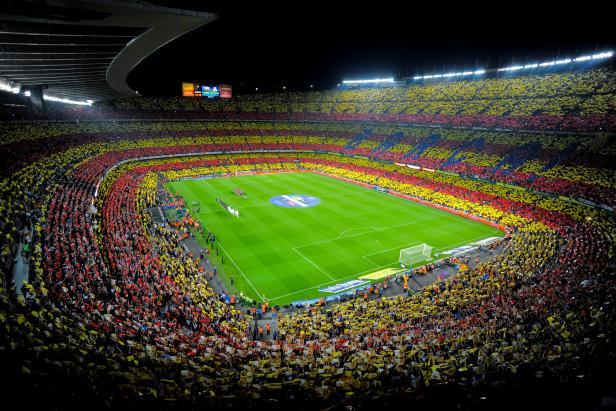Why is it popular?
The sport of Soccer, or Football as most of the world calls it, reigns high above all other athletics with an estimated fanbase of 3.5 billion, beating the runner-up, Cricket, by 1 billion fans. The simplicity and inexpensive nature of the sport allows it to be played in every corner of the globe, including the richest and poorest parts of every country. It only requires a ball and goals, which are created using anything from rubber bands and shoes to intricate technology and high-quality nets such as in the Premier League. The rules themselves are very simple and are learned quickly by most.
Moreover, billions of people find solace in the beautiful game, as they use it as a way to escape their busy lives, making it more than just a sport for them. The rich heritage makes many countries extremely intertwined with the sport, producing some of the world’s best athletes and making it their ambition to represent their country on the biggest stage. Soccer creates a huge sense of pride for one’s country, as the whole population comes together to support their team in the various international tournaments. The United States doesn’t represent this commonality though, and unlike most of the world, the U.S. has multiple sports which remain more popular than soccer. One can only wonder, why doesn’t the U.S. love soccer just as much?

What Separates Soccer?
FIFA
The governing body of International soccer, known as FIFA (Fédération Internationale de Football Association) has control over many aspects of global soccer, including international play, sports development, and importantly, the financial side of the sport. FIFA is divided into six conferences, CAF (Africa), AFC (Asia and Australia), UEFA (Europe), CONCACAF (North & Central America and the Caribbean), OFC (Oceania) and CONMEBOL (South America), each of which extends FIFA’s jurisdiction to every part of the world.
Their twin missions, to “evolv[e] into a body that can more effectively serve our game for the benefit of the entire world” and to support the development of soccer in almost every nation, affect many aspects of countries, especially through their financial support of many 3rd world countries’ national teams. Although the NFL garners massive amounts of money and rivals FIFA’s income, FIFA also exists as a political entity, controlling huge amounts of power and influence in global affairs. The mere existence of such a powerful entity for a sport represents the uniqueness of soccer, as no other sport rivals the power that it holds.
Relegation and Promotion
Unlike American sports, most soccer leagues (except the MLS) have a system of relegation and promotion in their league play. This means that a team that finishes in the very bottom of the league standings on the last match week (usually the last 2-3 teams depending on the league) is subject to relegation to a lower league. Every European soccer league has many subdivisions under their first division, so when a team gets relegated, they are sent down to the league that is 1 level below their current league.
For example, in the 22-23 Premier League season, Southampton finished in the last position and was relegated to the Championship (division 2). On the other hand, Burney finished in the 1st position in the Championship, so they were promoted to the Premier League (1st division). This system gives continual importance to every single game the team plays all season long. Because of the threat of relegation or the hope of promotion, the team will play their best in every game because every single point is vital to their league position.
Additionally, unlike being separated into different divisions like American sports, soccer leagues are all in one table (group), and all play each other two times in the season to fight for the first place position. American sport’s lack of a relegation system creates teams that are not good but stay in the same league, leading to occurrences such as tanking for draft picks and a hesitancy to play a team’s best players, simultaneously creating a more boring team and sport for the fans.
Another positive aspect of this system is for the occurrences such as the current Premier League side Luton Town, who began as a non-league soccer team (5th tier) in 2014 and fought their way to a Premier League spot despite their financial weakness and below-average capacity home stadium. This phenomenal story is hard to put into perspective for someone who isn’t a soccer fan and can only be compared to a single-A baseball team fighting their way into becoming an MLB team. The system is vital to the popularity of soccer but is unlikely to get adopted by American sports because of the team owners, who are unwilling to commit to a team that could possibly drop to a lower division and lose revenue. Because of this, teams will continue to be careless in league play, and fans will be continually disappointed with indifferent teams. With soccer, fans choose one team, and their loyalty constantly shows through their team’s good spells and bad, including up and down the divisions.

Rivals
Soccer is one of the oldest established sports in the world, which also means that the teams are among the oldest in the world. Most of the world’s teams were created in the 19th- 20th centuries, and some began playing each other more than 100 years ago. Major rivalries in world soccer formed during those times and still exist today, creating exciting games filled with passion, love, and hatred.
Some of the most famous rivalries in the world include:
FC Barcelona vs. Real Madrid (El Classico – Spain)
Celtic FC vs. Rangers FC (The Old Firm Derby- Scotland)
Boca Juniors vs. River Plate (The Superclasico – Argentina
AC Milan vs Inter Milan (Milan Derby – Italy)
Liverpool vs Manchester United (The North West Derby – England)
Bayern Munich vs Borussia Dortmund (Der Klassiker – Germany)
Such examples display the deep-rooted history of the sport, as well as the massive amount of pride the fans have in their team and the love the players have for the badge on their jerseys.
All of the rivalries formed in unique ways. For example, The North London Derby (Tottenham Hotspur vs Arsenal Gunners) was formed when the Arsenal team was relocated to northern London in 1913, a location already held by Tottenham. When the first league was expanded by two teams (the first spot already being claimed by Chelsea), the other spot was expected to be decided between Tottenham and Barnsley; however, Arsenal won the vote and were promoted to the first division despite their recency to the area. This created immense anger and resentment towards Arsenal, as the Tottenham organization believed Arsenal used bribery to get the remaining spot. Due to this, the North London Derby was created and continues to exist with the same vigor and passion as in the start. This story shows how deeply rooted soccer is in the community, and how much love all of the fans have for their team and the sport.

Transfer Market
Like most sports, soccer has a system for acquiring players. The soccer transfer market rotates on two open market periods and are referred to as the transfer windows. These two windows are during the summer and winter, with the latter only being 1 month long during January. Contracted players are sold to other teams, and the fee that comes with the player is known as the “transfer fee.” While this is not a novel idea for soccer to utilize, unlike other sports, soccer’s billion-dollar transfer market allows teams to buy and sell players among all continents and leagues. This diversifies teams, and despite the accepted “homegrown rule” that requires a team to have 8 players who were locally trained, exotic players allow for an interesting representation of global talents that are assembled to a singular team.
For example, the SPL (Saudi Pro League) side Al-Hilal have 10 non-Saudi players on their team, many of whom they purchased in the summer 23’ transfer window for a remarkable amount of money. Moreover, the transfer market creates frequent circumstances where large European teams purchase prodigious young talents from smaller teams in order to develop them into stars. Not only that, but the market’s recent inflation has led to star players becoming more expensive. Teams will make massive money moves for stars that will revitalize the squad and add extremely good talent. For example, Neymar Jr.’s transfer from FC Barcelona to Paris Saint Germain in 2017 cost the team 222 Million dollars in fees.
For comparison, the juxtaposition of soccer’s transfer market vs. the NBA’s free agency will show its superiority. The NBA operates on a trading system allowing teams to directly trade for players and money. Most often, teams will bundle players and trade for a player, players, or draft pick. One massive aspect of the NBA’s trading and salary regulations is the enforcement of a salary cap, which limits the amount of players and money a team can spend at a given time. This also means a team is limited from buying out multiple large-contract players.
On the contrary. soccer does not perform direct player trades, rather utilizing cash-swap deals. Teams are allowed to offer other teams an amount for one of their players, and the value of the player is subjectively valued by the team that has the player under contract, although modern-day market evaluations are accurate to skill level. The owning team can also request an adjustment to the offer given if they value the player as more valuable than the amount put forward. To put this system into perspective, it would be as if the Dallas Mavericks offered 100 million to the Bucks for Giannis Antetokounmpo, and the Bucks adjusted the offer to meet their desired value. This system avoids the strenuous process of price matching and trade packages that currently exist and allows more freedom in the market for direct transfers. The Mavs would simply need to agree with the Bucks for a certain price amount that would entice them into ending their contract with Giannis, to which the Mavs would offer him a new contract.
Youth Teams
In soccer, instead of having a draft like American sports, teams build their own team by developing their own players in soccer academies. Its aspects have their similarities to the U.S. college system, but are also very unique and allow for soccer teams to develop skilled players without having to rely on draft picks and trades. In soccer, teams will have a system of youth teams that are separated by age and invite kids to play for free. They invest money into training and playing the kids so they can develop them into the specific type of players they want. This also means they can call up the people on these youth teams to play for the senior team at any given time. Youth teams add an interesting factor to soccer teams, and the value of a team also includes the skill level of their youth teams and growing players.
The only comparable system that exists in the U.S. is the MLB minor leagues, which also have separate teams in which the senior teams are able to call up the players. Despite them having the single A, double A, and triple A, they still have to get these prospects from the draft or signing free agents. Soccer allows the teams to scout kids and offer them contracts, and the teams can also buy youth team players from other teams. For example, the Spanish team Real Madrid purchased the Brazilian 16-year-old Endrick for 60 million from a South American team, and he was not even able to go to Spain until he is 18.

League Tournaments and the World Cup
International and in-season tournaments are something that the U.S. is just beginning to experiment with. The NBA instituted its first occurrence of the NBA In-Season Tournament, which garnered lots of positive feedback from the American audience. This format of added tournaments is nothing new to soccer as almost every league has 3 to 4 tournaments available to the teams every year. For example, in Europe, the best 4 teams from the top leagues in each of England, Spain, France, and Germany, as well as the champions of the Netherlands, Austria, Serbia, and Scotland all qualify for the UEFA Champions League. The Champions League takes these top teams and allows them to compete in a completely separate tournament that gives them a completely different trophy from league play. The Champions League is not the only extra tournament. For example, in England alone, the teams can compete in the Champions League (foreign), the FA Cup (domestic), the EFL Cup (domestic), and the FA Community Shield (domestic). Those 4 tournaments allow extra games beyond the 38 match weeks that they play on league plays, allowing for more match weeks and more fan excitement.
Additionally, soccer offers the FIFA World Cup, which is the biggest sports tournament in the world. This tournament generates billions of dollars for the sport, as nations from all across the world are represented in the world’s largest competition. The insane amount of pride and excitement is a reflection of soccer’s world popularity. In the tournament, which occurs every 4 years in rotating locations, 32 teams battle in a group stage to knockout style tournament. This tournament is seen as the paramount of awards, the pinnacle of achievable greatness that serves as the dreams of billions worldwide.

In Conclusion
These varying factors of soccer make it very unique and interesting to follow. Its massive popularity causes there to be many different leagues and teams, and there will always be games occurring at all times of the day, literally. U.S. fans can choose various teams from different leagues to support, meaning they can constantly cheer for them. Additionally, the number of tournaments makes all games have more significance than the average American sport, meaning every game can be more interesting and impactful. The U.S. should watch more soccer because it offers a completely unique and invigorating sport-watching experience, one that is different from all the domestic sports leagues.






